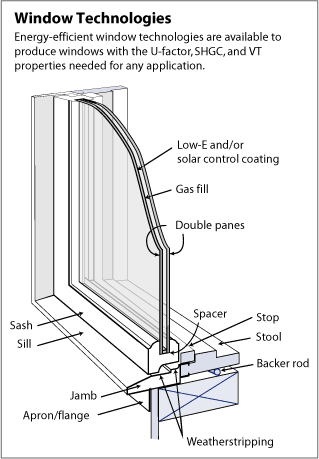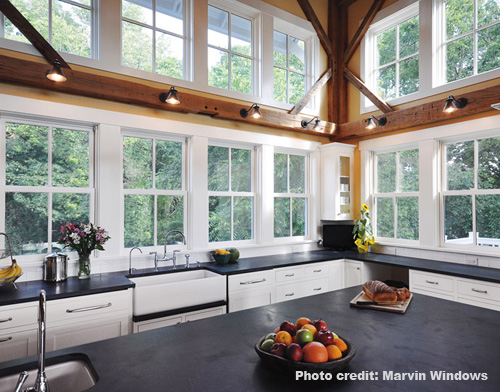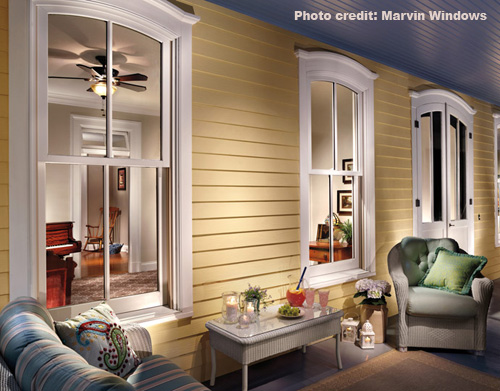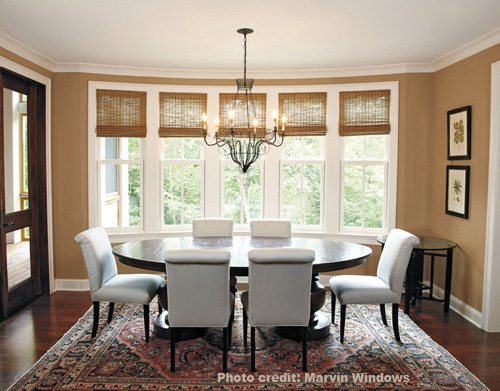
Have you ever had one of those door-to-door salesmen come to your home to push contractor services? They eyeball your house before they knock to see what upgrades your home “needs,” and they have prepared rebuttals for all the counter arguments. Usually I can get rid of them pretty quickly. My roof and windows were replaced within the last 5 years, and the exterior of my house is in decent condition- brick veneer and aluminum siding. Even if that weren’t the case, I hate the high-pressure sales tactics and almost immediately cut off their sales pitch. If you’re like me and prefer to shop around, do your own research, and compare quotes, this window guide will be a helpful reference.
The Cost
There are lots of factors to consider if you’re going to replace your windows, and cost is usually the biggest concern. Paying for new windows and installation can easily run $5,000+ for a small home. If you have lots of windows and want all the bells and whistles, expect to pay three or four times that amount. Here’s another tidbit to consider. Consumer Reports writes that replacing your old windows will result in 10 – 25% in annual savings. That means you won’t recover your investment any time soon. While cost isn’t the only deciding factor, don’t fall into the trap of thinking you’ll make back the money within a few years.
Installing your own windows is a great DIY project, and you’ll save around $300 per window. If you’re considering doing this job yourself, check out our article about installing replacement windows.

R-Values, U-Values, SHGC and VT
R-Value: R-value is a measure of a materials ability to resist heat flow (a.k.a. insulating ability). Higher R-values mean better insulation and result in less heat lost to the outside world. This value is based on the center of the window and is actually lower around the edges. R-values depend on several factors like number of glass panes, size of the air pocket between, glazes used and window frame qualities.
U-Value: U-value indicates how quickly the window will lose heat (transfer energy) due to the indoor and outdoor temperature, and is actually the inverse of the R-value (U = 1 / R). Lower U-values mean less heat loss. U-values lower than 0.35 are considered energy efficient.
SHGC Coefficient: SHGC refers to the solar heat gain coefficient. This is a measure of solar radiation admitted through a window (how much of the sunlight makes it inside as heat). SHGC ranges from 0 to 1. Look for an SHGC rating of 0.4 or lower in warm climates and 0.55 and higher for cold climates. Swing climates should be in-between. If a lot of your windows face east or west, definitely keep this in mind as you’ll have lots of sun hitting your windows.
Visible Transmittance: VT is expressed as a number between 0 and 1, and it measures how much visible light a window lets in. Usually higher VT is better but you should consider what’s right for your home’s lighting needs.

Multiple Glass Panes
Double and triple glazed windows are much more efficient than single pane windows. The space between two panes of glass can act as an additional layer of insulation. This is achieved by measuring the optimal space between the glass panes to increase R-value, and filling that space with an invisible, inert gas such as Argon. The panes are separated by a spacer. Metal (Aluminum) spacers can act as a heat bridge so look for ones composed of materials like plastic, foam and rubber that are much more efficient.
Energy Efficient Window Glazes
Special glazes can be applied to windows to boost efficiency even higher.
Low-E coating: Low emissivity refers to a super-thin metallic coating that will increase insulation and reflect heat. This will reflect solar heat away during summer months, and reduce heat loss during winter months.
UV block: Windows can also be coated to block around 75% of UV energy. This is important as sun light can fade carpet, furniture and more. We’ve also seen how UV light can lighten/darken the color of hardwood flooring.

Insulated Window Frames
Energy Efficiency shouldn’t stop at the window frame. Frame material and construction is just as important as the window itself.
Wood Frames: Wood frames provide good insulation with an approximate U-value of 0.4. However, they require some maintenance. Wood frames need to be painted or stained. Wood is susceptible to rot, termite and becoming warped. Consider a wood frame clad in vinyl or aluminum for improved durability and decreased maintenance.
Vinyl Frames: Vinyl frames are a great option. Vinyl is durable and also non-conductive (U-value around 0.4). No need to worry about insects, rot or painting vinyl frames. The only complaints are that vinyl can fad over time and they tend to leak air a bit more. Insulated vinyl frames can be pricey but will drop the U-value to around 0.2.
Aluminum Frames: Aluminum frames are not as popular anymore as they are poor insulators with U-values around 2. However, Aluminum is durable and requires little maintenance.
Fixed Windows: Fixed windows are exactly what they sound like- they are fixed in place and won’t open or close. We used of these in our bay window because they are airtight.

All this information should be considered specifically for your climate zone. To help determine what factors are most important use this handy Climate Zone Finder from the Energy Star site.
Graphic from U.S. Department of Energy







I just replaced all of my windows last summer. We were redoing the siding and adding insulation (polyiso to the exterior of the sheeting) so we used new construction windows. I wish I would have done more reading at the time on SHGC because I would have had my south facing windows have a higher rating so when the sun is low in the winter months, more heat would be gained. My eaves are wide enough (30″) that they shade the summer sun on that side of the house.
Great summary of many of the ratings and options one should research when looking for new windows.
Some of the windows in our house were replaced before we bought it, they’re newer vinyl. The rest of the windows are original, single pane (with exterior storms). They’re leaky… but I think I can spend the time every winter putting the window film on to keep the heat in, I really cant justify replacing them when they’re still mostly functional.
You mentioned Fixed windows, but what about double hung and casement? casement windows are everywhere in Europe, and apparently are much more efficient. I also like how much airflow they provide when open, because the opening is twice as big as a double hung window.
I hadn’t considered casement windows but they do seem like a great option if you like the style. Seems like window screens and cleaning are the only challenges. Great input.
Joe, I replaced all my sliding windows with casements. I like them way better. There are grid options that can make them look like double hung. They open much wider and can be oriented in a way that can “scoop” the breeze into the house as the wind comes by.
In the winter we remove all the screens and store them in the garage. Also they can all be cleaned from inside the house if opened all the way. Marvin even makes a casement that flips around for cleaning.
I did not know there were casement options that had the grids in them to match traditional double-hung models. That’s a nifty option, especially for our neighborhood where the HOA mandates grids in windows.
I think you are following me around my house writing articles based on our plans! Another timely post for me. While this older house has character, it is also energy inefficient. We desperately need new windows. But the cost has prevented us from biting the bullet. I did not realize that replacing them could be a DIY project. I will be checking out the other post you mentioned and researching more. Thanks!
Scary how this is on my todo list for my mom’s house and you write a piece about it. I’d better check to see if Ethan is hiding in the bushes or something. 🙂
Hehe! Haven’t resorted to hiding in the bushes… yet.
I find window shopping to be quite overwhelming, even when you know what you’re looking for. The biggest challenge is that anyone who comes out to your house (e.g., Home Depot salesperson) will have a limited offering for you to choose from – when you should really start with what you need from a materials perspective and then find the right installer… Windows are one of those things that are usually bought on “trust”, “marketing”, and “looks” rather than on an objective review of the merits of the windows.
We replaced (almost) all of the windows in our condo a couple of years ago. The energy savings was great, but my favorite thing was that the noise from the highway a few blocks away was completely gone. Yay!
A great resource when shopping around is the National Fenestration Ratings Counsel.gov website, nfrc.gov. They have a breakdown of most of the energy efficient window ratings in the industry and you can even compare.